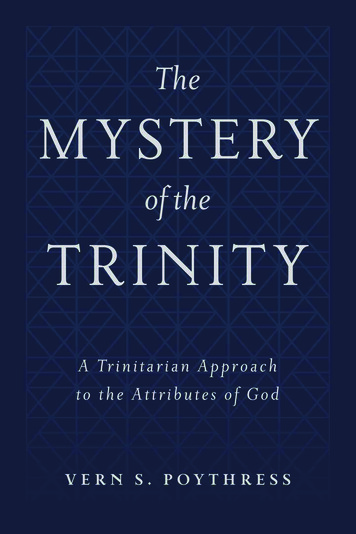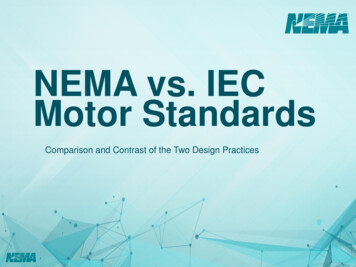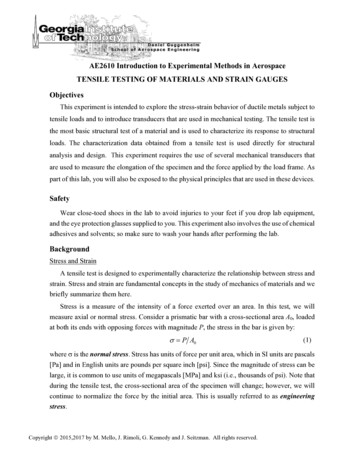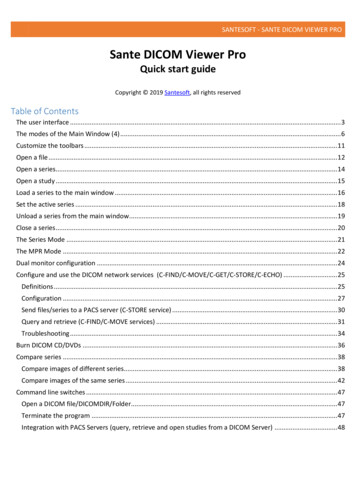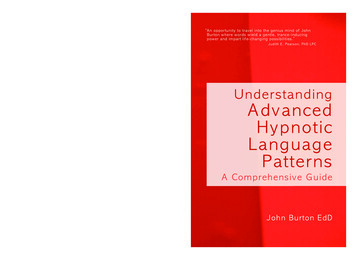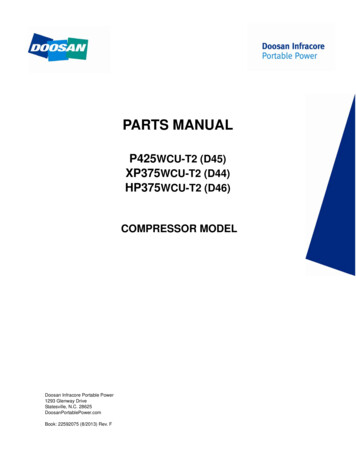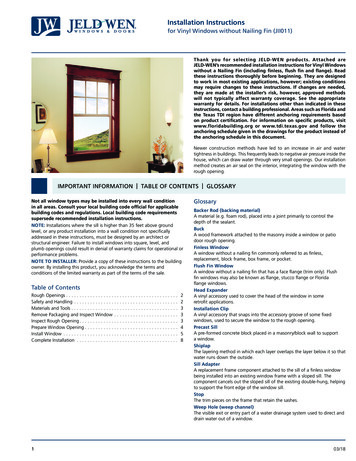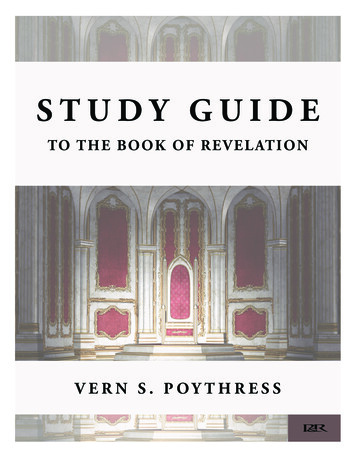
Transcription
STUDY GUIDETO T H E B O O K O F R E V E L AT I O NV E R N S . P OY T H R E S S
2017 Vern S. PoythressScripture quotations are from ESV Bible (The Holy Bible, English Standard Version ). Copyright 2001 by Crossway Bibles, a publishing ministry of Good News Publishers. Used by permission. Allrights reserved.This study guide may be printed, photocopied, and distributed in unlimited copies, and translatedinto other languages, all according to the provisions of Creative Commons Attribution-ShareAlike 4.0International (CC BY-SA 4.0), https://creativecommons.org/licenses/by-sa/4.0/.
CONTENTSIntroduction to Studying Revelation1. The Glory of Christ2. Christ’s Messages to Ephesus, Smyrna, Pergamum, and Thyatira3. Christ’s Messages to Sardis, Philadelphia, and Laodicea4. God on His Throne5. The Lamb Takes the Sealed Scroll6. The Lamb Opens Six Seals, Bringing Judgments7. Interlude: Protection for the Saints8. The First Four Trumpets and Their Judgments9. The Judgments of the Locust Plague and the Vast Army10. A Scroll Containing Prophecies for John11. Measuring the Temple and Witnessing12. The Woman and the Dragon and Their Symbolic Histories13. The Beast and the False Prophet14. The 144,000, the Angelic Proclaimers, and One like a Son of Man15. The Prelude to the Judgments of the Seven Bowls16. The Seven Judgments from the Seven Bowls17. The Fall of Babylon the Prostitute18. Seven Messages about the Fall of Babylon19. The Marriage Supper of the Lamb and the Final Battle20A. The Thousand Years20B. The Last Judgment and the New World21. The Holy City Jerusalem22. The Garden Paradise and Concluding ExhortationsBibliography
I N T RO D U C T I O N TO S T U D Y I N G R E V E L AT I O NMany people consider the book of Revelation intimidating. But God meant it to be profitable for us(2 Tim. 3:16–17). If we have a proper starting point, it can be both exciting and spiritually edifying.This booklet is meant to provide a short introduction and then questions for each major section ofthe book of Revelation. It is suitable for use in individual study or a group study. The questions aregrouped according to the paragraphs of Revelation, so that people can choose to study a single paragraph during an individual or group study, or go over several paragraphs at one sitting. In most cases,study can begin with the introductory material here, before proceeding to study the individual paragraphs and chapters.People who want more information can turn to commentaries on Revelation. I myself haveprovided a short introduction and commentary: Vern S. Poythress, The Returning King: A Guide to theBook of Revelation (Phillipsburg, NJ: P & R, 2000). For fuller treatment, you may turn to Dennis E.Johnson, Triumph of the Lamb: A Commentary on Revelation (Phillipsburg, NJ: P & R, 2001). The besttechnical commentary is G. K. Beale, The Book of Revelation: A Commentary on the Greek Text (GrandRapids: Eerdmans; Carlisle: Paternoster, 1999). This last commentary is also available in shortenedform, about half the size of the original: G. K. Beale and David Campbell, Revelation: A Shorter Commentary (Grand Rapids: Eerdmans, 2015).The Purpose of RevelationMany people either fear the Book of Revelation or have an unhealthy interest in it. But Goddesigned this book for a very different purpose. Revelation is meant to produce in you comfort, courage, hope, and praise. Do you believe that?Look at the very beginning of Revelation. Rev. 1:3 says, “Blessed is the one who reads the wordsof this prophecy, and blessed are those who hear, and who keep what is written in it, for the time isnear.” God knew that many people would feel timid about this book—that many would say to themselves, “I can’t understand it.” So he gave you special encouragement to read it. Make a point of readingit once or more during the next few months.In the verse I just quoted (1:3) we already receive a hint about the contents of Revelation. Godtells us to “keep what is written in it.” Revelation does not give us information just to tickle our fancy.We are meant to “keep” it, to take things to heart. We ought to be transformed by what we read, tobecome more faithful servants of Christ. The Book of Revelation is a very practical book.Note also what it says in 1:1: “The Revelation of Jesus Christ, which God gave him to show tohis servants the things that must soon take place.” To whom is the Book of Revelation written? Notto PhDs, to experts, to prophecy fans, to a narrow inner circle of specialists. God writes it to “his4
servants”—the servants of Jesus Christ. If you are a follower of Christ, this book is for you. You canunderstand it, because God knows how to communicate to you. In addition, let me say the obvious.The Book of Revelation is a revelation, “the revelation of Jesus Christ” (1:1). “Revelation” means anunveiling, a disclosure, a display of who God is and what he promises to do. The Book is not a concealment, a puzzle, a riddle, as some people think. It is not a puzzle book but a picture book. Its messageis so clear that a child can grasp it and be encouraged.1. What is the purpose of Revelation?2. In what way is it accessible to ordinary readers?3. How might reading it be an encouragement?The Message of RevelationHow can I make such bold claims? I will tell you. The message of Revelation is this: God ruleshistory, and he will bring it to its consummation in Christ. The heart of this message is expressed inRevelation 4 and 5. John is given a vision of God seated on his throne (4:2). Here is the king of theuniverse. He is no idle monarch. His will and his orders created the universe long ago (4:11). Hiswill now is that the whole universe should join in praise of the Lamb (5:11–14). From his throneissue the orders for governing history up to its climax, the time when Christ appears. At that timewe will say, “Hallelujah! For our Lord God the Almighty reigns. Let us rejoice and exult and givehim the glory, for the marriage of the Lamb has come” (19:6–7). God shows us in Revelation howhe is in control, how powerful he is, and what the future must bring. We come to know that God’spromises are trustworthy and that his power is invincible. Hence we can begin to praise God evennow, and to sing “Hallelujah!” over his reign. Do you begin to see how encouraging the Book ofRevelation can be?Look again at Revelation 1:1. God shows “to his servants the things that must soon take place.”What is the word “must” doing there? Things “must” take place only because God rules over historyand makes sure that they do take place. In the very first verse of Revelation God already hints atthe theme that will develop in the course of this book. As we move further into chapter 1, God isintroduced as “him who is and who was and who is to come” (1:4). God is. He is self-sustaining, allsufficient. God was. He always has been, from eternity. He is the creator and owner of all things. God“is to come.” The future that must come is the future defined by God. God will come himself! Godwill appear, and will ring down the curtain on the course of history.Revelation is above all a God-centered book. This book is designed to stir your imagination. Itsets before you in indelible pictures the truth that we most need to take to heart: God is the King! Allthe nations are as nothing before him (Isa. 40:17). “He does according to his will among the host ofheaven and among the inhabitants of the earth; and none can stay his hand or say to him, ‘What haveyou done?’ ” (Dan. 4:35). His goodness, his magnificence, his beauty, his bounty, are the source of allblessing (Rev. 22:1, 4:2). The climax of history comes when “the kingdom of the world has become thekingdom of our Lord and of his Christ, and he shall reign forever and ever” (Rev. 11:15). Jesus Christis King of kings and Lord of lords, who will wage war against God’s enemies until all are subdued to5
him (Rev. 19:16; 1 Cor. 15:24–25). We find our fulfillment as we serve and praise this marvelous King(Rev. 19:1–10).1. What is the message of Revelation in a nutshell?2. How does the message of Revelation have a practical thrust?3. How do you react to the message of God’s rule over history?How to Read RevelationHow then do you read the Book of Revelation? Read it prayerfully. Jesus Christ is the source of this Book (Rev. 1:1). He alone can give youspiritual eyes and hearts to understand it. Pray to the Lord that he would interpret this bookto your heart. Focus on the central theme. Read Revelation to see what it says about God ruling history andbringing it to consummation in Christ. Read for the big picture. Don’t be discouraged whenyou do not understand some detail. Most people who get into difficulty fail right here. Theywant to understand the details and to predict future historical pinpricks before they have evenbegun to absorb the central message. They are doing things the wrong way around. Nobodycan properly understand the details of a book without first understanding the main points. Be God-centered. Otherwise, you will be like someone who takes holds of a knife by the bladeinstead of the handle. Or you will be like someone who tries to understand a beautiful painting by looking in a magnifying glass at each blob of paint on the canvas. Focus on the hope for the coming of Christ. Watch how the whole book points forward toChrist’s return. Let the images “soak into you.” Get involved in the Book. Don’t try to puzzle it out. Enjoy it.Sing about it. Cheer for the saints. Detest the beast. Rejoice in God’s power and glory. Praisethe Lamb. Pay attention to Old Testament themes and images that are used in a fresh way. The book ofRevelation has many allusions to Daniel, Ezekiel, Zechariah, and the breadth of the Old Testament. Becoming familiar with the Old Testament will help you deepen your appreciation ofRevelation, even though the basic message of Revelation comes through to all the servants ofChrist. Recognize that the central part of the book is a prophetic vision given by God to John. Prophetic visions are full of symbols. They are symbolic representations of spiritual truth, notphotographic copies of events. Use this book in times of distress, persecution, and death. Christians of all ages testify that itspeaks powerfully to people in deep trouble.1. What are some guiding principles in reading Revelation?2. How do these principles help to keep readers on track with the message?6
The Organization of RevelationMany people feel lost when they read Revelation. One vision comes after another until they aredisoriented. Actually, the book of Revelation is carefully and beautifully organized. It is like a Persianrug. To those who become familiar with it, it reveals an intricately interwoven pattern of exquisitebeauty. But the patterning is so complex that a newcomer can feel the need for guidance.The theme of Revelation is—remember?—that God rules history and will bring it to its consummation in Christ. So what is the most important event? Naturally, the second coming of Christ, whichbrings history to its climax. When we mark off the descriptions of the Second Coming, Revelationdivides itself neatly into parts. Seven visionary histories each lead up to a description of the SecondComing. Before these histories begin, there are two introductory sections, containing a vision of Christand his messages to the churches. Here is an outline.The first part of the outline is based roughly on Rev. 1:19. Part III of the outline is divided sothat each “cycle” leads up to a description of the Second Coming. Each cycle pictures for us someaspect of the events leading up to the Second Coming. But each takes a different focus. In addition,the later cycles contain more intense judgments and lead up to the Second Coming more quickly. Bythe time that we come to cycle 6, the whole cycle focuses on the Second Coming rather than the eventsleading up to it.To organize your thinking about these cycles in a convenient way, use the analogy of warfare.In cycle 1, the 7 seals, God sends out 4 horsemen, indicating that he commissions the warfare. Cycle2 describes effects on the earth. In cycle 3, symbolic histories indicate the depth of the conflict andopposition between the two armies and their leaders. Cycle 4 describes further effects on earth, moreintense and comprehensive than before. Cycles 5, 6, and 7 describe the final elimination of theopponents: the elimination of Babylon the seductress (17:1–19:10), the elimination of the powerful persecuting foe (the beast, 19:11–21), and the elimination of the ultimate source of evil (Satan,20:1–21:8).1. What is the overall organization of the book of Revelation?2. How does this organization help you understand where the book is going?Holy WarIn Revelation two kingdoms and two armies are poised opposite to one another. The kingdomof God will triumph, but it is opposed by the kingdom of Satan. God controls the whole course of thebattle, but it is waged partly among unseen angelic and demonic powers who operate alongside andbehind human beings. Human beings have their own role to play, because their commitments andactions display their loyalty to God or to Satan.We must realize that in all of history, this spiritual battle is going on. Revelation enlightens ourspiritual eyes to see the true state of affairs in this universe and in our lives.The principal actors characteristically appear in visionary form in Revelation. They are brought7
on stage one by one, as if in a drama. Then God pronounces judgment on them, in the form ofrewards or punishments. They are then taken off stage in the reverse order, as the following outlineshows.The characters form two groups. God and his servants are opposed by Satan and his servants,who endeavor to counterfeit God’s work. We may diagram the relations as follows:1.2.3.4.What is the most basic conflict in Revelation?Who participates on the two sides of the conflict?Where are you in the conflict?How does understanding the conflict help in applying the message to ourselves?The Challenge of RevelationRevelation challenges you to see the world and your life for what it is: a scene of spiritual warfare.There are no noncombatants, no truces, no mercy from the Satanic opponents. But there is victory,brought to a climax when Christ returns. In the meantime, you must be loyal to Christ, your commander and chief. You must obey him, worship him, honor him, praise him without compromise inall your life.You must beware primarily of two kinds of threats: from the Beast and from the Prostitute Babylon. The Beast represents persecuting power. The state, especially in totalitarian countries, threatensto make it difficult for Christians, to impoverish them, to cause them pain, even to kill them if they donot compromise. You must not give in to the Beast, and you must pray that your brothers and sistersin other countries would be strong in faith, looking to their reward from Christ.The Prostitute represents seduction by pleasure, prosperity, and economic advantage (see Rev.17:4, 18:3,19). In Western countries, the blandishments of unbridled pleasure seduce Christians intosurrendering their purity. You must stir yourself up to see the consequences of unlawful pleasure(18:4–8), the beauty of holiness (19:7–8), and the superiority of the lasting pleasures of fellowshipwith God (22:1–5). Pray that your fellow Christians also would be pure in all their lives.1. In what ways does the spiritual conflict appear in our own times and cultures?2. How does Revelation help us to respond?Major Options for Interpreting RevelationOver the course of church history, interpreters of Revelation have disagreed with one anotherprimarily about the question of the time of fulfillment of the prophecies of Revelation. There are fourmajor schools of interpretation.First, the Roman Empire interpretation (which scholars call “preterist”) believes that the bulkof the prophecies were fulfilled in the first few centuries, especially in connection with the fall of the8
Roman Empire. The beast of Rev. 13:1–8 represents the Roman Empire in its persecution of Christians. An alternate form of this approach connects the prophecies primarily with the fall of Jerusalemin 70 A.D.Second, the Final Crisis interpretation (“futurist”) believes that the prophecies will be fulfilledat the second coming of Christ and in the events of final crisis immediately preceding the SecondComing. The beast represents the final Anti-Christ who will severely persecute God’s people duringthe final crisis.Third, the Church History interpretation (“historicist”) believes that the prophecies are fulfilledin the history of the church from the first century until the Second Coming. The narrative of Revelation is assumed to be in exact chronological order. The early chapters (for example, Revelation 2, 3,and 6) relate to events in the first few centuries, the middle chapters (Revelation 13) relate to events ofthe Reformation, and the later chapters (Revelation 18, 19) related to events immediately before theSecond Coming. The beast represents the Pope in Reformation times.Fourth, the General Principle interpretation (“idealist”) believes that the prophecies depict general patterns of conflict that repeatedly occur throughout the period between the first and secondcomings of Christ. The beast represents state persecution of Christians throughout this age.In my opinion, all of these except the Church History interpretation have considerable merit.The Roman Empire interpretation is relevant, in view of the detailed knowledge of the seven churchesdisplayed in Revelation 2–3, the threat of persecution that those churches experienced (2:10, 13), andthe thematic connections between Revelation 2–3 and the rest of the book. We cannot ignore thatChrist was expressing his concern and encouragement to those people back there, not merely writingdirectly to us now.The Final Crisis interpretation is relevant, in view of the fervent hope that Rev. 22:20 expressesfor the Second Coming, and the way in which earlier parts of the book all lead up to passages thatuse language associated with the Second Coming. Second Thessalonians 2 clearly indicates that a finalcrisis preceding the Second Coming will involve a climactic outbreak of a pattern of wickedness thatexists earlier (2 Thess. 2:6–8).The General Principle interpretation is relevant, in view of the fact that Revelation claims to berelevant to all the servants of Christ (1:1), and in view of the fact that Paul teaches us explicitly thatthere is a general pattern of conflict (2 Thess. 2:7). The General Principle approach also explains howthe Roman Empire interpretation and the Final Crisis interpretation can in a sense both be right, sinceboth are looking at one manifestation of the general principle. Part of the power of the symbolism ofRevelation lies in its fluidity: it is capable of being applied to a multiplicity of cases through churchhistory, and thereby serving to encourage and instruct Christians in every generation. Even the ChurchHistory interpretation is not entirely wrong, since it too finds events that are one manifestation of theprinciples of Revelation.In view of the element of truth in these approaches, I recommend that we anticipate the possibility of fourfold fulfillment of the great bulk of prophecies in Revelation. (1) Any particular prophecyfinds a fulfillment of a preliminary kind in the Roman Empire period. (2) The prophecy finds a climactic fulfillment in the Final Crisis. (3) The prophecy finds fulfillment throughout the age, in that it setsforth a general pattern delineating the character of spiritual war throughout. (4) The prophecy findsfulfillment now, in our time. Our time is not necessarily special, but simply because we live when we9
live, we are obliged to think through with greater care what the implications of Scripture are for ourpresent situation.1. What are the four major options for interpreting the book of Revelation that have beenadopted over the course of church history?2. Which have you heard about most from popular media?3. In what way might there be some truth in each of them?For Further ReadingVern S. Poythress, The Returning King: A Guide to the Book of Revelation. Phillipsburg, NJ: P&R, 2000.Dennis E. Johnson, Triumph of the Lamb: A Commentary on Revelation (Phillipsburg, NJ: P&R, 2001).10
Study Guide to the Book of Revelation1T H E G LO RY O F C H R I S TChapter 1 is important. It has a prologue in 1:1–3 that explains the origin of the book and sets thetone for the whole of the book of Revelation. It introduces the human author (John) and Christ in hisglory (1:12–20), who will give messages to the seven churches (Rev. 2–3) and is the key to the book(Rev. 5:5).(An individual or a group studying Revelation can choose to take a whole chapter at a time, orgo more slowly by taking paragraphs one by one.)A. Read Rev. 1:1–51. Who is the human author?2. Is anyone else involved in the production of the book? If so, who? Why? [draw diagram of transmission]3. To whom is the book addressed? (verses 1 and 4)4. How are the contents of the book described? (verse 2)5. What benefit is promised?11
6. What is the meaning of “revelation”?7. What role does Jesus Christ have?8. What hints are there about understanding the book?9. How does the book have practical value to us?10. Compare Dan. 2:28 with v. 1, “soon.”B. Read Rev. 1:4–81. What themes are introduced?2. Who is the source of blessing in v 4–5?12
3. How is God named and why? (verses 4, 8)4. Who are the seven spirits?5. What do we praise God for?6. What do we learn about the character of God?7. What event is predicted?8. Why is important to mention these things?13
9. What should we take to heart (v 4)?C. Read Rev. 1:9–161. What is the situation for John?2. How might this affect the practical value of the book?3. What is being said through the description in 12–16?4. Where is Christ standing?5. What do the features mean?14
6. What is the OT background? (See Dan. 7:9-10, 13-14; Ezek. 1:26-28.)7. What do we learn about Christ?D. Read Rev. 1:17–20.1. How does John respond and why?2. What does the response tell us about Jesus?3. How does Jesus describe himself and why?4. What encouragement do we receive from him?15
5. How is this whole vision (1:12–20) an encouragement to you?6. What are the promises to us implicit in this passage?16
Study Guide to the Book of Revelation2C H R I S T ’ S M E S S AG E S TO E P H E S U S ,S M Y R N A , PE RG A M U M , A N D T H YAT I R ARev. 2–3 contain seven messages from Christ to seven churches of Asia Minor (now, Western Turkey). The difficulties of these churches also include lessons for us today (“He who has an ear, let himhear . . .”).Read each message to each church separately.A. Questions on Rev. 2:1–7 (the church in Ephesus)1. Who writes the message?2. Where does the description of Jesus come from? What does it reveal about Jesus?3. How does Christ show his glory?4. What commendable things are true of the church at Ephesus?17
5. What is their failure?6. What is the remedy?7. What promises and threats does Jesus give?8. How is our church like or unlike Ephesus?9. What temptations and assurances apply most forcefully to your life?18
B. Questions on Rev. 2:8–11 (the church in Smyrna)1. How does Jesus describe himself? What does it reveal about him? How is this relevant to otherbelievers and to us?2. How does Christ show his glory?3. What commendable things are said about the church at Smyrna? Are there any failures?4. What promises does Jesus give?19
5. How is our church like or unlike Smyrna?6. How do you see these promises as applying to you?C. Questions on Rev. 2:12–17 (the church in Pergamum)1. How does Christ show his glory?2. What commendations does Christ give?3. What are the difficulties and threats at Pergamum? [For information about Balaam, see Num.22-24. For the temptation set up by Moab, over which Balak was king, see Num. 25:1-5.]20
4. What do you think is the principal difficulty or root difficulty?5. What does Christ call for?6. What promises and threats does he give?7. In what ways is our church like or unlike Pergamum?8. How does this passage challenge you or comfort you?21
D. Questions on Rev. 2:18–29 (the church in Thyatira)1. How is Christ described, and why (see v. 23)?2. How does Christ show his glory?3. What commendations does Christ give?4. What criticisms does he make?5. Who is “Jezebel” and what is she doing? [For information about the Old Testament Jezebel, see1 Kings 16:31; 18:4, 13; 19:1-2; 21:1-16; and 2 Kings 9:7-10, 22, 30-37.]22
6. What seems to be the central problem?7. Why do you think people are tempted in this way?8. What promises and threats does Christ give?9. How is our church like or unlike Thyatira?23
10. How does this passage challenge you or comfort you?E. General:1. Can you find a general pattern in the organization of the seven messages? What are commonfeatures? What commonalities are there in order?2. What does this imply for the whole church (“universal church”)?3. What are the promises to the “one who conquers”?24
Study Guide to the Book of Revelation3C H R I S T ’ S M E S S AG E S TO S A R D I S ,P H I L A D E L P H I A , A N D L AO D I C E A[Review Rev. 2.]Continue to read each message to each church separately.A. Questions on Rev. 3:1–6 (the church in Sardis)1. How does Christ show his glory?2. What does Christ commend?3. What does he criticize?4. What is the central underlying problem?25
5. What does Christ call for?6. What does Christ threaten? promise?7. How is our church like or unlike Sardis?8. How does this passage challenge you or comfort you?B. Questions on Rev. 3:7–13 (the church in Philadelphia)1. How does the description of Christ relate to the rest of the message (see v. 8)?26
2. How does Christ show his glory?3. What does Christ commend?4. What does he criticize?5. What does he promise and/or threaten?6. How is our church like or unlike Philadelphia?27
7. How does this passage challenge you or comfort you?C. Questions on Rev. 3:14–22 (the church in Laodicea)1. How does the description of Christ relate to the rest of the content?2. How does Christ show his glory?3. What does Christ commend? (maybe nothing?)4. What does he criticize?5. What is the central problem?28
6. What does Christ threaten and promise?7. How is our church like or unlike Laodicea?8. How does this passage challenge you or comfort you?D. General1. When you compare all seven churches, how do they differ? How are they similar?29
2. How does Christ show his glory in each message?3. What have you learned by looking at the similarities and differences?4. What lessons do you think are most relevant to your church and to other churches in your areaof the world?30
Study Guide to the Book of Revelation4G O D O N H I S T H RO N ERev. 4 is a visionary picture of God’s sovereign rule over creation and history, a rule that guarantees hisfinal victory.Read Rev. 4.1. How does John come to see the vision?Who is instrumental in it?In what respects is John unique and in what respects like us?2. What features stand out in this vision?3. How does the vision make you feel?31
4. What is central to this vision?5. How do the surrounding things enhance our understanding of God?6. What are we supposed to learn about God from the vision as a whole?7. How do you think the vision is related to the later actions of God in Revelation?8. How do the 24 elders and 4 living creatures express their relation to God?32
9. What do they thereby say about our relation to God?10. What do the songs show about the singers?11. What do the songs show about God?12. How does this vision connect with the final new Jerusalem of Rev. 21–22?33
Study Guide to the Book of Revelation5T H E L A M B TA K E S T H E S E A L E D S C RO L LRev. 5 shows that the Lamb alone is worthy to accomplish redemption and thereby bring God’s purposes to pass.Read Rev. 5.1. What individuals and groups are involved here?2. What do we learn about the Lamb before he is even introduced?3. See Dan. 9:2; 12:4 for divine books with plans.4. How is the Lamb described? Who is he? What do we learn about him?34
5. How is he worthy?6. What do we learn about redemption?7. How should we react to the descriptions of worship?8. How does this vision anticipate the end of all things?9. How does this vision challenge you in your relation to God?35
Study Guide to the Book of Revelation6T H E L A M B O PE N S S I X S E A L S ,BRINGING JUDGMENTSIn Chapter 6, the Lamb opens six of the seven seals on the scroll. The visions emphasize God’s rule overhistory, including disasters. The six visions lead up to the second coming of Christ, which is describedin the sixth seal (see the seven cycles of judgment described in the introduction).A. Read Rev. 6:1–8.1. What are the principal actors involved in these scenes?2. Where is the starting point for the action in each scene?3. Where did the sealed book come from (hint: look at 5:1–3, 7)?4. What do you think is in the sealed book (hint: look at Dan. 7:10; 12:4)?36
5. How do these scenes relate to God’s plan for history?6. Other than God the Father—seated on the throne—who is crucial in the opening of the book,according to Rev. 5:1–3, 7?7. What is the role of the four living creatures in the scenes? Where do they get their authority?8. What are some Old Testament backgrounds for these scenes? Hint: Zech. 1:8–10; 6:1–8; Josh.2:1; 2 Kings 7:13–15.9. What is the first rider like (Rev. 6:1–2)?37
10. How is this fulfilled? When? Hint: when in history would be the most natural times of fulfillment? John’s time (Roman Empire)? Just before the Second Coming? Repeatedly?11. Under whose plan does the rider act?12. What are the second, third, and fourth riders like? What is predicted in each case? (Maybe drawa diagram,
the book of Revelation. It is suitable for use in individual study or a group study. The questions are grouped according to the paragraphs of Revelation, so that people can choose to study a single para-graph during an individual or group study, or
